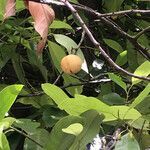| Therapeutic use
|
Analgesics (bark), Joint dislocations (bark), Child health (bark), Cooling effect on body (bark), Diarrhea (flower), Abdominal pain (fruit), Abortifacient agents (fruit), Acne vulgaris (fruit), Immunostimulant (fruit), Hair loss (fruit), Amenorrhea (fruit), Analgesia (fruit), Analgesics (fruit), Anemia (fruit), Anthelmintics (fruit), Anti-bacterial agents (fruit), Antiemetics (fruit), Antifungal agents (fruit), Anti-inflammatory agents (fruit), Antinematodal agents (fruit), Antioxidants (fruit), Antipyretics (fruit), Antirheumatic agents (fruit), Antitussive agents (fruit), Aphrodisiacs (fruit), Appetite stimulants (fruit), Ascites (fruit), Asthma (fruit), Colic (fruit), Common cold (fruit), Contraceptive agents (fruit), Cough (fruit), Cystitis (fruit), Delirium (fruit), Dental caries (fruit), Diabetes mellitus (fruit), Diarrhea (fruit), Diarrhea, infantile (fruit), Dysentery (fruit), Dysmenorrhea (fruit), Dyspepsia (fruit), Eczema (fruit), Edema (fruit), Disorder of ejaculation (fruit), Elephantiasis (fruit), Epilepsy (fruit), Erectile dysfunction (fruit), Expectorants (fruit), Eye diseases (fruit), Fatigue (fruit), Flatulence (fruit), Gastric acid (fruit), Headache (fruit), Helminthiasis (fruit), Hemorrhoids (fruit), Hyperlipidemias (fruit), Insect repellents (fruit), Joint dislocations (fruit), Kidney calculi (fruit), Laxatives (fruit), Leprosy (fruit), Leukorrhea (fruit), Liver diseases (fruit), Low back pain (fruit), Malaria (fruit), Measles (fruit), Freckles (fruit), Menorrhagia (fruit), Menstruation (fruit), Mouth diseases (fruit), Nausea (fruit), Nervous system diseases (fruit), Neuralgia (fruit), Ointments (fruit), Paralysis (fruit), Parasympatholytics (fruit), Periodontitis (fruit), Increase physical endurance, strength and stamina (fruit), Poliomyelitis (fruit), General tonic for rejuvenation (fruit), Sciatica (fruit), Skin diseases (fruit), Smallpox (fruit), Splenic diseases (fruit), Sprains and strains (fruit), Stomach diseases (fruit), Stomatitis, aphthous (fruit), Thirst (fruit), Ulcer (fruit), Urinary bladder calculi (fruit), Urinary tract infections (fruit), Uterine diseases (fruit), Vomiting (fruit), Wound healing (fruit), Cooling effect on body (fruit), Stomach diseases (seed), Anti-bacterial agents (leaf), Antifungal agents (leaf), Antineoplastic agents (leaf), Asthenia (leaf), Brain diseases (leaf), Diarrhea (leaf), Exanthema (leaf), Heart diseases (leaf), Insecticides (leaf), General tonic for rejuvenation (leaf), Sterilization, reproductive (leaf), Urination disorders (leaf), Sexual debility (leaf), Anti-bacterial agents (root), Whitlows (seed), Abdominal pain (seed), Amenorrhea (seed), Anti-bacterial agents (seed), Anticonvulsants (seed), Antidepressive agents (seed), Antifungal agents (seed), Anti-infective agents (seed), Anti-inflammatory agents (seed), Antinematodal agents (seed), Antineoplastic agents (seed), Antioxidants (seed), Antirheumatic agents (seed), Antitussive agents (seed), Anxiety disorders (seed), Aphrodisiacs (seed), Appetite stimulants (seed), Arthritis (seed), Asthma (seed), Bronchitis (seed), Cardiotonic agents (seed), Celiac disease (seed), Central nervous system depressants (seed), Chemoprevention (seed), Cholinergic antagonists (seed), Colic (seed), Common cold (seed), Contraceptive agents (seed), Cough (seed), Diarrhea (seed), Diarrhea, infantile (seed), Digestive system diseases (seed), Dysentery (seed), Dysmenorrhea (seed), Dyspepsia (seed), Dyspnea (seed), Disorder of ejaculation (seed), Elephantiasis (seed), Flatulence (seed), Hallucinogens (seed), Headache (seed), Heart diseases (seed), Helminthiasis (seed), Hyperlipidemias (seed), Immunosuppressive agents (seed), Insecticides (seed), Joint dislocations (seed), Laxatives (seed), Leukorrhea (seed), Locomotion (seed), Freckles (seed), Menorrhagia (seed), Molluscacides (seed), Mouth diseases (seed), Nausea (seed), Neuralgia (seed), Nootropic agents (seed), Paralysis (seed), Parasympatholytics (seed), Radiation-protective agents (seed), General tonic for rejuvenation (seed), Rhinitis (seed), Sinusitis (seed), Skin diseases (seed), Skin diseases, infectious (seed), Sleep initiation and maintenance disorders (seed), Sprains and strains (seed), Ulcer (seed), Vomiting (seed), Sexual debility (seed), Abortifacient (unspecified), Aphrodisiac (unspecified), Asthma (unspecified), Astringent (unspecified), Bactericide (unspecified), Bladder (unspecified), Cancer (unspecified), Carminative (unspecified), Digestive (unspecified), Dysentery (unspecified), Dysmenorrhea (unspecified), Dyspepsia (unspecified), Fever (unspecified), Flu (unspecified), Gastromegaly (unspecified), Halitosis (unspecified), Infection (unspecified), Inflammation (unspecified), Intestine (unspecified), Leprosy (unspecified), Liniment (unspecified), Malaria (unspecified), Narcotic (unspecified), Osteosis (unspecified), Parturition (unspecified), Perfume (unspecified), Pneumonia (unspecified), Poison (unspecified), Puerperium (unspecified), Rheumatism (unspecified), Sciatica (unspecified), Sclerosis(Spleen) (unspecified), Spice (unspecified), Stimulant (unspecified), Thrush (unspecified), Tonic (unspecified), Urogenital (unspecified), Ache(Stomach) (unspecified), Flux (unspecified), Hallucinogen (unspecified), Herbicide (unspecified), Impotence (unspecified), Insanity (unspecified), Psychedelic (unspecified), Sprain (unspecified), Abdomen (unspecified), Anodyne (unspecified), Apertif (unspecified), Cramps (unspecified), Nausea (unspecified), Paralysis (unspecified), Spasm (unspecified), Stomachic (unspecified), Tumor(Liver) (unspecified), Amenorrhea (unspecified), Analgesics (unspecified), Anthelmintics (unspecified), Anti-bacterial agents (unspecified), Anticonvulsants (unspecified), Antidepressive agents (unspecified), Antifungal agents (unspecified), Anti-infective agents, local (unspecified), Anti-inflammatory agents (unspecified), Antineoplastic agents (unspecified), Antioxidants (unspecified), Antipyretics (unspecified), Antitussive agents (unspecified), Aphrodisiacs (unspecified), Appetite stimulants (unspecified), Asthenia (unspecified), Cardiovascular diseases (unspecified), Colic (unspecified), Common cold (unspecified), Contraceptive agents (unspecified), Cough (unspecified), Diarrhea (unspecified), Digestive system diseases (unspecified), Diuretics (unspecified), Erectile dysfunction (unspecified), Expectorants (unspecified), Eye diseases (unspecified), Flatulence (unspecified), Graves ophthalmopathy (unspecified), Headache (unspecified), Helminthiasis (unspecified), Liver diseases (unspecified), Menstruation-inducing agents (unspecified), Narcotics (unspecified), Parasympatholytics (unspecified), Anti-poisoning (unspecified), General tonic for rejuvenation (unspecified), Sinusitis (unspecified), Skin diseases (unspecified), Sleep initiation and maintenance disorders (unspecified), Splenic diseases (unspecified), Stress, physiological (unspecified), Thirst (unspecified), Ulcer (unspecified), Urination disorders (unspecified), Vomiting (unspecified)
|

